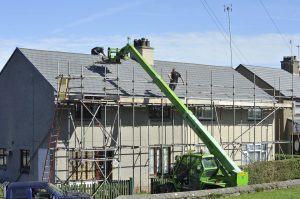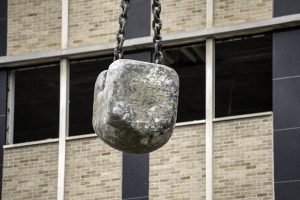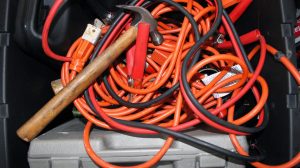The construction industry offers exciting work for people who like a busy, fast-paced environment. But construction sites can be littered with heavy machinery, pressurized tools, and sky-high scaffolding, making them potentially dangerous. Let’s take a look at the top three construction site hazards and how workers can protect themselves from injury.
FALLS
According to OSHA, 39% of construction-related deaths in 2017 were from falls, making it the leading cause of death in the construction industry. Keeping workers safe while in the air involves the right equipment and training. OSHA requires that construction workers wear fall protection equipment if they’re working at a height of 6 feet or higher. When working above the ground, follow these safety rules:
- When on a roof: Wear a personal fall arrest system with a harness and anchors that fit properly and are regularly inspected. Workers must be trained on how to use the equipment correctly so they stay connected or tied off while on the roof.
- When on a ladder: Ensure that it is set up on flat, solid ground. Always have three points of contact on the ladder at all times, meaning two feet and one hand, or two hands and one foot.
- When on scaffolding: Ensure that it’s been erected by trained professionals and inspected before each use. Be aware of proper tool usage while on scaffolding and load capacity of the scaffolding. Always be aware of anyone nearby, as tools can fall from it or scaffolding can collapse if not properly assembled.
 Falls can be devastating, both for workers and the companies they work for. For this reason, there is an enormous amount of training material available from OSHA as well as organized events to support fall prevention. To learn more, click here.
Falls can be devastating, both for workers and the companies they work for. For this reason, there is an enormous amount of training material available from OSHA as well as organized events to support fall prevention. To learn more, click here.
STRUCK-BY HAZARDS
Struck-by hazards are the second leading cause of death of construction workers. There are four different types of struck-by hazards—flying, falling, swinging, or rolling objects.
 Flying objects include anything that is propelled through the air and can cause an injury, such as a nail from a nail gun or a bolt from the track of a front-end loader.
Flying objects include anything that is propelled through the air and can cause an injury, such as a nail from a nail gun or a bolt from the track of a front-end loader.
Falling objects can pin or crush workers and include debris, construction materials, or tools.
Swinging objects can not only hit and injure workers, but they can also push workers off surfaces and cause a major fall, like off a scaffolding or ladder. Windy conditions can cause hoisted objects to become very dangerous swinging objects.
Rolling objects include things that are rolling or moving on the same level as the worker, such as a cart, car, or truck. Workers can be run over or dragged, causing injury or death.
Struck-by incidents can happen at any time and be caused by human error or faulty equipment, so it’s imperative that workers do the following to stay safe:
- Always wear Personal Protective Equipment (PPE), including harnesses, helmets, steel-toed boots, eye and face protection, high-vis safety wear, etc.
- Understand how to properly use hand tools, transport heavy equipment safely, maneuver trucks around worksites, work with overhead equipment, etc.
- Take precautions when weather creates a difficult environment in which to work
- Always be aware of your surroundings, including other workers and vehicles
ELECTROCUTION
 Electrocution is the third highest cause of death among construction workers, but it can also cause burns, explosions, and fires. Electrocution can happen by hitting overhead power lines with equipment, using equipment with exposed wires, or using extension cords incorrectly.
Electrocution is the third highest cause of death among construction workers, but it can also cause burns, explosions, and fires. Electrocution can happen by hitting overhead power lines with equipment, using equipment with exposed wires, or using extension cords incorrectly.
To avoid electrocution, take the following precautions:
- If working around power lines, ask the local utility company to ground the lines while work is underway.
- Inspect all extension cords to make sure they’re in proper working order. Discard any frayed or broken cords and replace them with new ones.
- Make sure your wiring is protected by a GFCI so that power will automatically be shut off if there is a dangerous imbalance between the outgoing and incoming current.
Regular safety trainings should be on every construction company’s schedule. Westwind’s Safety Coordinator Sam Bishop holds trainings every month. “Here at Westwind, our workers’ safety is our first priority,” says Bishop. “That’s why we hold regular safety trainings for Westwind team members as well as our sub-contractors to ensure that our job sites are safe environments for everyone. We participate in annual safety campaigns, such as OSHA’s Safe & Sound Week, and often host MIOSHA inspectors and trainers at our classes. Our standard for safety at Westwind is high, and we consistently reward good safety practices and attitudes when we see it.”
For more information on these and other construction hazards, check out OSHA’s Construction page.